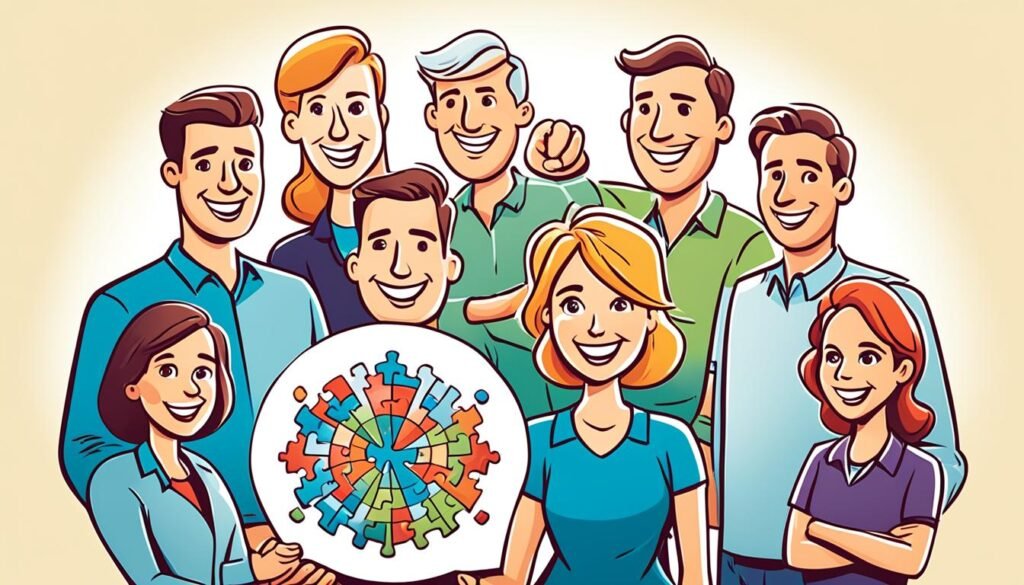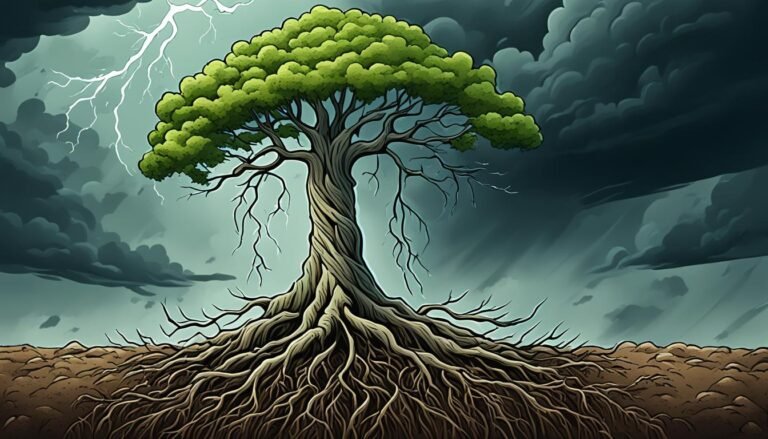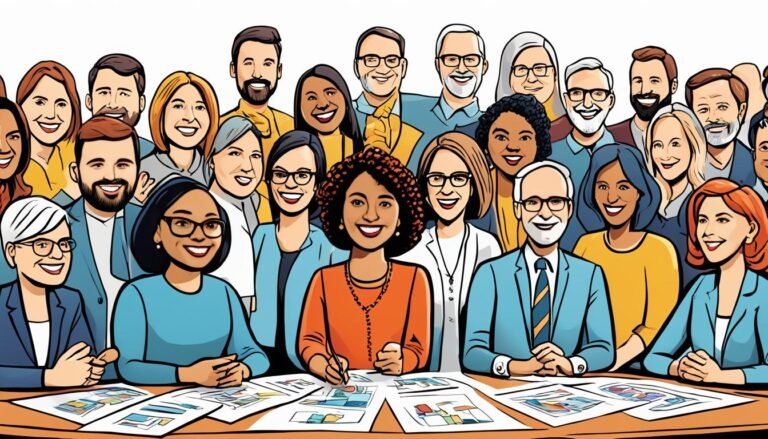Leadership Recognition: Valuing Contributions
“The greatest leader is not necessarily the one who does the greatest things. He is the one that gets the people to do the greatest things.” – Ronald Reagan
A good work culture values people’s efforts. It is key for success. It boosts happiness, teamwork, and performance. It makes workers feel they are part of something important. This article looks at how recognizing leadership can make workplaces better.
Key Takeaways
- Employee recognition is crucial for retaining top talent and increasing employee engagement.
- Recognition plays a vital role in shaping the company culture, fostering teamwork, trust, and loyalty.
- Different types of recognition programs, including monetary and non-monetary rewards, peer-to-peer recognition, and social recognition, can be implemented based on the organization’s needs.
- Recognition fulfills psychological needs, increases motivation, job satisfaction, and overall well-being.
- Effective leadership qualities, such as vision, integrity, empathy, and communication skills, are crucial for creating a positive work environment.
The Importance of Employee Recognition
Employee recognition is key to any organization’s success. It not only keeps the best workers but also boosts everyone’s performance. It makes the whole team more engaged.
When workers are praised for their efforts, they feel loyal. They tend to stay longer and do more than expected. This keeps the team strong and motivated.
Recognition also shapes a great work atmosphere. It shows how every worker matters. This inspires pride and effort in the job. Fair rewards and promotions make morale even better.
“Employee recognition is not just a nice thing to do. It’s a communication tool that reinforces and rewards the most important outcomes that people create for your business.” – David Niu
Companies that value employee recognition often see happier workers. Happy workers are more productive. Their work is better, leading to great outcomes for the company.
Recognition is a way to show employees they matter. It motivates them to do their best. By applying such programs, a company shows it cares about its workers. This leads to a work culture where everyone tries to excel.
The Impact of Employee Recognition
Employee recognition changes a workplace for the better. It encourages teamwork and sharing. Everybody works together more smoothly and efficiently.
Plus, it builds loyalty. Valued workers are more committed. This commitment lowers turnover. It also boosts satisfaction and loyalty to the company.
The Benefits of Employee Recognition:
- Retains top talent
- Increases employee engagement
- Encourages high performance
- Fosters a positive company culture
- Boosts job satisfaction
- Enhances teamwork and collaboration
- Improves productivity and performance
- Reduces turnover rates
Recognizing employees isn’t just a gesture. It’s a smart move for business growth. A workplace that acknowledges hard work is both welcoming and inspiring. It not only draws in great talent but also pushes existing employees to do their best.
The Impact of Recognition on Company Culture
Recognition is vital for shaping company culture. When a company values its employees’ efforts, it creates a positive work atmosphere. This recognition boosts a sense of belonging. It helps in teamwork, improves trust, loyalty, and pushes for continuous growth.
Positive company culture: Recognizing employees builds a positive culture. It makes staff feel valued and more motivated. This culture boosts engagement, satisfaction, and well-being.
Teamwork and collaboration: Recognition also strengthens teamwork. It encourages employees to help each other and share ideas. Working together then boosts productivity and problem-solving.
“Recognition is a powerful motivator that brings people together and creates a sense of unity and shared purpose.”
Increased trust and loyalty: By recognizing hard work, trust and loyalty grow. Employees start trusting their leaders more. This leads to better relationships, job satisfaction, and a commitment to the company.
Culture of continuous improvement: Recognition drives continuous improvement too. It inspires employees to do better and enhance their skills. This effort results in better standards, more innovation, and lasting success.
Recognizing the Power of Recognition
Understanding recognition’s role is key for a positive workplace. By valuing what employees do, companies can see big benefits. This includes better teamwork, trust, loyalty, and always striving to do better.
Different Types of Recognition Programs
Recognition programs are key in showing employees we value their hard work. There are many kinds to choose from, to fit what your organization needs. They help create a culture where people feel appreciated.
1. Monetary Recognition
Money-based programs give bonuses or raises. They make people feel good right away and push for better work.
2. Non-Monetary Recognition
These programs don’t use money to say thanks. They might include prizes, certificates, or special events. They’re all about making people feel proud and happy about their work.
3. Peer-to-Peer Recognition
People can tell each other ‘great job’ in these programs. It boosts teamwork and makes everyone feel closer. Getting recognized by co-workers is very respectful and meaningful.
4. Social Recognition
These are events or meetings to celebrate accomplishments. They let everyone see and celebrate your success. It makes the team stronger and happier.
“Recognition comes in many ways: with money, without it, from team members, or in public meetings. All are important.”
Each program type has something special to offer. They can mix and match to create a strong appreciation strategy. This keeps employees happy, engaged, and loving their workplace.
Telling your team ‘good job’ and rewarding them improves their satisfaction and loyalty. It’s smart for companies to have good recognition programs. They make people stay, work hard, and feel good about what they do.
After looking at recognition types, we’ll next chat about why recognition feels so good.
The Psychological Impact of Recognition
Recognition is vital for meeting the basic psychological needs of employees. It makes them feel part of the group and their efforts valued. This sense of belonging and validation is crucial.
Being noticed boosts employees’ morale and job happiness. It inspires them to keep working hard. As a result, productivity goes up and everyone, from the worker to the company, benefits.
Recognition also affects personal happiness and self-worth. It makes employees feel good about themselves and what they achieve at work. This, in turn, increases their enjoyment of work and strengthens their commitment.
Recognized employees also feel a stronger tie to their workplace. They feel loyalty and as if they truly belong. This helps create a warm and productive work environment, reducing turnover and increasing job satisfaction for all.
When peers see others getting recognition, it boosts morale for everyone. A culture that values celebrating success emerges. Not only individuals but teams benefit from this.
To sum it up, recognition deeply affects employees’ psychology. It boosts motivation and overall happiness at work. Companies that value recognition have happier, more committed staff. This leads to a workplace that is vibrant and motivating for all.
Intrinsic vs. Extrinsic Motivators in Employee Recognition
Employee recognition is key to keeping workers motivated and involved. It builds a positive work culture that supports teamwork and high results. Two kinds of motivators stand out: intrinsic and extrinsic.
Intrinsic motivators are rewards that come from inside a person. This includes wanting to grow personally, feel accomplished, or make a difference. They link to satisfaction at work and how connected an employee feels to their job.
Extrinsic motivators are rewards from the outside, like money, promotions, or praise. They’re used to encourage certain actions and reward standout work. Such rewards can boost spirits and effort in the short run.
Both types are crucial in recognizing employees. External rewards offer quick satisfaction and perks. Inner motivators drive long-term attachment and happiness with the job. A mix of both makes for a comprehensive and successful way to appreciate employees.
“A well-designed recognition program combines both intrinsic and extrinsic motivators to create a positive work environment and drive employee engagement.” – John Maxwell, HR Consultant
A culture that balances both kinds of motivators sees happier, staying, and performing workers. By recognizing individual growth and achievements, companies spark purpose and belonging. They make employees feel cherished and driven.
Programs emphasizing intrinsic rewards boost creativity and innovation. Workers who are recognized this way are more likely to tackle big challenges. They put their best foot forward, helping the company succeed.
Mixing intrinsic and extrinsic rewards is vital in employee programs. It helps build a culture that values effort, boosts productivity, and cares about employee happiness. With this mix in mind, companies can grow with motivated, engaged employees.
The Qualities of Great Leaders
Great leaders have a mix of qualities that make them stand out. They can push, inspire, and guide their teams to victory. These traits include things like having a clear vision, strong integrity, and understanding other people’s feelings.
Vision
A leader with vision sees a bright future for their team. They know the company’s goal and share it with others. This shared vision helps the team walk a path together, aiming for the same targets.
Integrity
Integrity is doing what’s right, always. Great leaders are honest and act with strong morals. Their trust and ethical behavior make a safe space for everyone to work together.
Empathy
Empathy is about truly understanding how others feel. Great leaders listen to their team and support their dreams. This creates a workplace where people help each other, feeling included and cared for.
Resilience
Resilience is the ability to keep going despite difficulties. Great leaders are tough and can handle problems well. They stay positive and keep their eyes on the goal, making the team believe they can win.
Adaptability
Change is quick, and great leaders are ready for it. They welcome new ideas and deal with uncertainties fast. Being adaptable helps them keep the team moving forward through innovation and improvement.
Communication
Good communication is key for great leaders. They are clear when sharing thoughts and feedback. Smooth talking and listening build trust and understanding in the team.
Influence
Great leaders change things just by being there. They motivate the team, guiding them to wins. Their power inspires others, giving everyone a shared purpose and drive.
| Qualities of Great Leaders | Description |
|---|---|
| Vision | Ability to imagine and articulate a compelling future for the organization. |
| Integrity | Honesty, trustworthiness, and a strong commitment to ethical behavior. |
| Empathy | Understanding and relating to the emotions and experiences of others. |
| Resilience | Capacity to bounce back from setbacks and adapt to changing circumstances. |
| Adaptability | Embracing change and adjusting strategies in response to new challenges. |
| Communication | Effective verbal and non-verbal communication skills to convey thoughts and expectations. |
| Influence | Ability to inspire and motivate others, guiding them towards success. |
Together, these leadership qualities build a great working environment. They drive success within the organization. With these traits, leaders inspire their teams, leading them to do amazing things.

The Role of Leadership Recognition for Managers
Leadership recognition is key to making a work environment better. It improves how engaged employees are and helps keep them for the long haul. Managers should value their team’s work as it builds loyalty, motivation, and devotion.
When we praise our team for their hard work, it lifts their spirits. It also links their success to our overall goals. Meaning, they see why they are important to the group, which makes them strive harder.
Recognizing the team’s efforts also builds a sense of teamwork. Valued employees tend to lift each other up. This kind of support boosts productivity and new ideas, which lead to team success.
Plus, recognizing our team makes them feel more involved. Engaged staff love their jobs more, are happy working, and want to stick with us. Creating a place where noticing good work is normal helps attract and keep great people.
This effort is more than just saying “good job.” It involves listening, guiding, and sharing in their wins, big or small. A complete recognition strategy helps managers and employees trust each other more. This trust keeps the team strong.
By properly recognizing leadership, managers shape a positive place to work. This encourages employees to do their best for the group’s success. It’s a vital step in making employees happy, keeping them, and building a top-notch culture.
Recognizing Good Leadership
Spotting good leaders is key for a positive workplace and team success. The best leaders have special skills that motivate, lead, and make a real difference.
Vision: Good leaders have a clear vision that they share with their team. They set goals and give direction, making sure everyone works towards one goal.
Communication Skills: Great leaders are great at talking. They listen well, speak clearly, and encourage open talks. This builds trust, helps in working together, and brings success.
Problem-Solving Ability: Leaders who tackle tough challenges and find new solutions really connect with their team. They take a proactive approach, looking at problems in new ways, and push for bettering their work.
Ethical Conduct: The best leaders act with high moral standards. They make choices based on what’s right, fair, and clear, building trust and respect.
Empathy: Showing understanding and care for others is key for leaders. They create positive bonds, making the workplace a caring and supportive place.
Achieving Results: Leaders who care about results set tough goals and push their teams to do their best. They cheer when goals are met, moving the organization forward.
Continuous Improvement: Leaders that want to get better inspire their teams to grow and learn. They push for new ideas, offer chances for self-improvement, and encourage a culture that welcomes change.
Noticing leaders with these skills is vital for a strong and successful team. By valuing great leadership, firms lay the groundwork for reaching amazing goals and making their people happy.
Conclusion
Leadership recognition is key in making staff feel valued. When leaders thank and praise their team, it makes the work environment better. This improves teamwork and morale.
When leaders notice and highlight an employee’s hard work, it stands out. It makes that person want to do even better. This boosts job happiness and the entire team’s success.
For a strong work community, bosses should show they care and notice their staff’s efforts. Making people feel appreciated and important helps. It builds a culture where everyone is eager to do their finest work.








